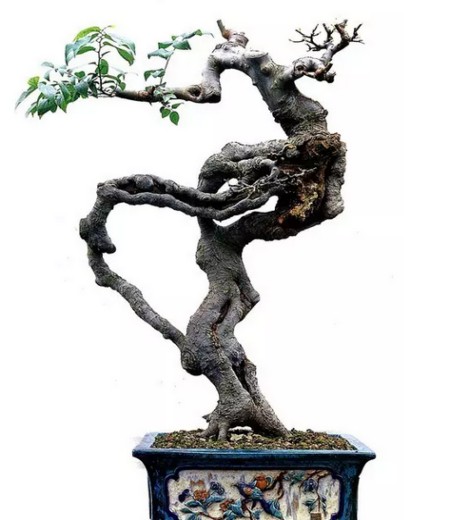Principles to be followed in bonsai design
Some people say that the aesthetic characteristics of Chinese bonsai art are "seeking elegance and refinement", paying attention to implication, artistic conception, paying attention to the combination of reality and reality, paying attention to levels and depth of field, so as to achieve "changing from finite to infinite","changing from boundary to unbounded", fascinating, fascinating and endless.

However, if summed up more refined, the aesthetic characteristics of Chinese bonsai art, one is small in the big, that is, famous mountains and rivers or ancient trees and flowers are collected in a pot, with artistic superb means to set out nature, the other is to maintain its vitality, a living sense of life injected into it.
Bonsai is by no means a reduced model of nature, whether it is landscape bonsai, tree stump bonsai or even flowers. Landscape bonsai, a small pot, can make Huangshan strange, Taishan male, Huashan dangerous, Emei show, but by no means their model, but through these stones, water, trees and the like, people will appreciate their own characteristics, tree column bonsai is also the case, no matter ancient pine strange cypress, plum column banyan, can be in a small bonsai show dignified, beautiful posture, bonsai should be alive, growing.
Bonsai design should follow the following four principles:
1, contrast and harmony principle plant landscaping design, tree shape, color, lines, texture, proportion, etc. must have certain differences and changes, showing the diversity of duties; but also maintain a certain similarity, forming a sense of unity, so that both lively and harmonious unity. Contrast is often used in design to highlight themes.
2, the principle of equilibrium and stability in the plane that the weight relationship is appropriate is balanced; in the elevation that the weight relationship is appropriate is stable.
3. Rhythm and rhythm principle The monomer of plant configuration repeats regularly, changes intermittently, produces rhythm in sequence repetition, and produces rhythm in rhythm change.
4, proportion and scale principle proportion refers to the garden scenery in the body shape has the appropriate relationship, which has both the scenery itself between the length, width, height of the proportion of relations, but also between the scenery, between the individual and the overall proportion of relations.
Time: 2019-05-23 Click:
- Prev

Bonsai art is a comprehensive plastic art of natural scenery.
Bonsai art creators use creative skills and reasonable layout to cultivate trees, flowers and plants with certain artistic shapes or mountains and rocks with different depths, widths, shapes, sizes, colors and textures in a variety of different depths, widths, shapes, sizes, colors and textures. to make it a landscape that mimics nature.
- Next

Good bonsai works can better reflect the true meaning of life.
Small bridge and flowing water is oblique, and there is a family in the depths. The long way back to the woodcutter was late, and flowers fell inadvertently. This is the artistic conception of bonsai art. I have lived in the city for a long time, and I often hear the roar of cars. I often see steel and concrete in front of my eyes, but I don't know that there are Taoyuan outside the world. In modern times, the appreciation of bonsai does not seem to be as deeply rooted in the hearts of the people as tea ceremony and incense.
Related
- Fuxing push coffee new agricultural production and marketing class: lack of small-scale processing plants
- Jujube rice field leisure farm deep ploughing Yilan for five years to create a space for organic food and play
- Nongyu Farm-A trial of organic papaya for brave women with advanced technology
- Four points for attention in the prevention and control of diseases and insect pests of edible fungi
- How to add nutrient solution to Edible Fungi
- Is there any good way to control edible fungus mites?
- Open Inoculation Technology of Edible Fungi
- Is there any clever way to use fertilizer for edible fungus in winter?
- What agents are used to kill the pathogens of edible fungi in the mushroom shed?
- Rapid drying of Edible Fungi

